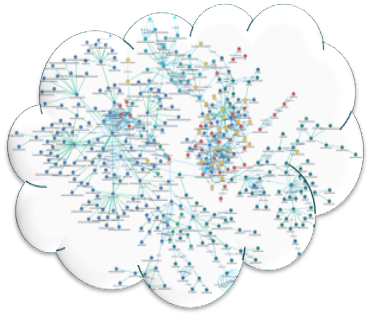
In a previous post that described knowledge graphs and their benefits, we discussed how knowledge graphs help organizations make more of their enterprise data easy to find, understand, and use so that analysts, data scientists, and other data consumers can use data and analytics more effectively and frequently to drive the business. This post argues for knowledge graph technology and discusses common application areas of knowledge graphs.
Organizations must consider using the graph data model and semantics to expose the business meaning and connections between data points across vast landscapes of previously siloed, complex data platforms. Why? Because this approach uniquely enables enterprise goals related to information architecture. The knowledge graph approach, powered by graph and semantics, empowers more data-savvy people in the business to build their own highly contextualized, enterprise-scale, analytics-ready datasets on a self-service, on-demand basis — shrinking the decision cycle while offering more complete answers and new insights.
Knowledge graphs are different partly because they allow users to ask unanticipated questions and rapidly execute exploratory queries against large volumes of data without building indexes or otherwise optimizing datasets for specific queries. By leveraging connections between data points in highly blended data sets, users can iteratively ask questions and get answers from large collections of enterprise data on demand.
For the “grizzled graph veteran” who might be skeptical of the scalability and feasibility of large-scale employment of knowledge graphs, I refer you to Cambridge Semantics’ Anzo platform which is powered by AnzoGraph.
AnzoGraph is the best large-scale graph query engine on the market. This graph query engine scales horizontally on commodity compute resources in clouds, on-premises or a hybrid of both. AnzoGraph boasts an in-memory, massively parallel processing (MPP) architecture that quickly loads data into memory and provides on-demand access to very large knowledge graphs. Recent benchmark results demonstrate its superior query performance.
Knowledge graphs help organizations by simplifying and accelerating data discovery and integration for end users, data scientists and analysts, who need to find, understand, and blend relevant data from across multiple siloed, complex, and enterprise data sources into analytics-ready data products.
Following are some application areas in which knowledge graphs excel and differentiate.
Entity 360 — Organizations can build comprehensive views of any entity of interest. For example, consider a pharmaceutical drug product. Information about a given drug product derives from many sources and perspectives. Sources include highly structured reference sources all the way to unstructured customer feedback. But it is important to create a comprehensive understanding across all channels to optimize insight, behavior, efficacy, and improvement. The knowledge graph approach provides the means to rapidly create, adapt and maintain a 360 degree view of an entity, while allowing individual sources to maintain ‘local’ perspectives (i.e., federated-enterprise data architecture).
Accelerate R&D — Link data related to specific targets, signals, persons, or technologies to accelerate development and innovation. Uncertainty is an inherent aspect of R&D and the knowledge graph helps the researchers cope gracefully by accommodating volatility and change. Knowledge graphs built using Semantic Web technologies “expect change” and allow additional data sources on the fly.
Pattern Detection — Find relationships and patterns of activity across entities, concepts, and assets to identify anomalies and potential indicators.
Optimize Analysis — Give analysts integrated information about available items of interest, products, and research to improve detection, understanding, assessment and reporting.
Unify Data Sources — Combine available datasets (databases, flat files, documents, etc.) to simplify search, exploration and on demand access to relevant information.
Integrated View of A Complex Business — Provide business users a single view of the business that spans siloed operating groups or merged entities. Create Enterprise as a Service (EaaS) to “know what the enterprise knows.”
Operationalize AI/ML and IoT — Create large-scale knowledge graphs in a data fabric architecture to operationalize Artificial Intelligence and Machine Learning (AI/ML) and Internet of Things initiatives.
Knowledge graph technology is deployed in production environments in multiple sectors including Pharma, Finance, Materials Science, Manufacturing, Defense, Intelligence and others.
A knowledge graph solution easily deploys as an overlay on top of an enterprise’s existing landscape of data platforms and dataflow without displacing or disrupting existing processes or platforms.
Knowledge graphs overcome severe limitations in contemporary data integration and access technologies and methodologies. The graph data model informed with semantics represents the future of enterprise data integration.
